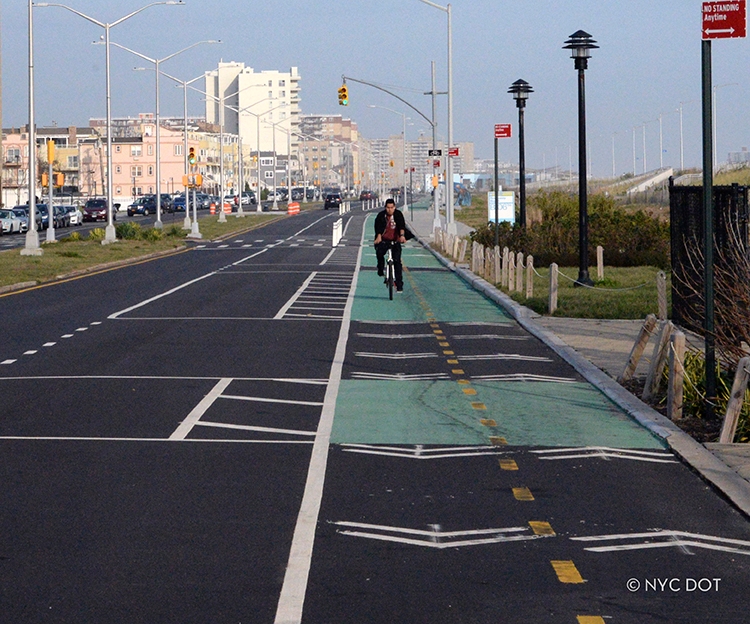Material selection for the right-of-way is crucial for creating infrastructure that is both sustainable and resilient. Selecting sustainable materials works to reduce environmental impacts through lower carbon emissions, resource conservation, and recyclability, supporting long-term environmental goals.
Resilient materials enhance infrastructure durability, enabling it to withstand extreme weather events, heavy traffic, and other stressors, thus reducing maintenance costs and extending lifespan. Incorporating materials such as porous pavements and recycled aggregates ensures that right-of-way constructions are adaptable to climate change while minimizing ecological footprints and promoting economic efficiency.
Material selection and design for projects in flood-vulnerable areas may involve additional considerations as resiliency best practices continue to develop. Consult the latest version of MOCEJ’s Climate Resiliency Design Guidelines.

Unified Stormwater Rule
DEP adopted the Unified Stormwater Rule (USWR) which represents a comprehensive update to the city's stormwater management policies, aiming to address both water quantity and quality requirements across combined and separate sewer areas.
Effective February 2022, the USWR integrates and enhances existing stormwater regulations. The USWR applies to all development projects, defined as any public or private development that disturbs 20,000 square feet (approximately 0.46 acres) or more of soil or creates 5,000 square feet (approximately 0.11 acres) or more of new impervious surfaces, such as rooftops, sidewalks, and pavements. These projects must adhere to stringent stormwater management requirements to mitigate the impact of runoff. Key mandates include the preparation of a comprehensive Stormwater Pollution Prevention Plan (SWPPP), which details stormwater management measures such as site maps, construction drawings, soil testing results, and erosion control practices.
The USWR emphasizes the use of retention-based Stormwater Management Practices (SMP) like bioretention, rain gardens, and permeable pavements to effectively manage stormwater on-site. DOT and DEP are utilizing Precast Porous Concrete Panels in the curb lane and the City continues to pilot other permeable treatments.
See Stormwater Management Practices in the Landscape Chapter.
For more information and guidance, consult the NYC Stormwater Manual, which provides technical guidance for developers, designers, and engineers working with DEP on stormwater permitting.
Carbon Reduction
Material selection for the right-of-way is crucial for creating infrastructure that is both sustainable and resilient. Selecting sustainable materials works to reduce environmental impacts through lower carbon emissions, resource conservation, and recyclability, supporting long-term environmental goals.
To further these goals, DOT is leading the way in sustainable street resurfacing by integrating recycled asphalt pavement (RAP), warm mix asphalt, and other advanced materials into its resurfacing operations. NYC DOT's current asphalt mixes contain 40% recycled materials, far exceeding the national average of 20%. In FY24, DOT incorporated 256,392 tons of recycled asphalt into its in-house pavement production. By using RAP, DOT repurposes old pavement, which reduces the demand for new raw materials and cuts down on landfill waste. By recapturing the milled material when resurfacing streets, DOT increases efficiency and cost-effectiveness by reducing the need for new raw materials, while also minimizing the environmental impacts associated with quarry mining and material transport.
DOT’s two in-house asphalt plants produce asphalt with an average of 40% RAP content and, as a result, DOT avoids two million miles of truck trips annually, which lowers congestion, emissions, and road wear. Additionally, the use of warm mix asphalt, which requires lower temperatures during application, decreases energy consumption, emissions, and odors, while extending the paving season and improving durability in extreme weather. This innovative approach enhances environmental sustainability and street maintenance efficiency.
DOT has also recently begun producing new RAP mixes containing up to 50% recycled material, further reducing fossil fuel use and old roadway pavement sent to landfills. Beginning in September 2024, DOT started testing this new mix at six locations in Brooklyn, covering 6.64 lane miles on low-traffic streets. This builds on past efforts, such as the 2022 pilot on Staten Island, where DOT paved three test strips using recycled plastic content and 40% RAP. That project diverted the equivalent of 214,534 plastic bottles from landfills and reduced CO₂ emissions by 16,128 pounds. DOT continues to monitor both pilots to assess performance, costs, and operational impacts, with the goal of incorporating these greener asphalt mixes into standard production if successful. For more details on these initiatives, visit the Sustainable Street Resurfacing page.
Additionally, DOT offers quality Recycled Concrete Aggregate (RCA) to private industry and community developments. The RCA Bank plays a key role in material reuse for construction projects, providing a sustainable sub-base material alternative to new aggregate material for use beneath roadways and sidewalks, supporting the City’s overarching recycling objectives.
Increasing the sustainability of materials used in the City’s infrastructure strengthens the resilience of our neighborhoods, economy, and public services in the face of climate change, including more frequent heavy rains, flooding, and extreme heat. Resilient materials improve infrastructure durability, allowing it to better withstand extreme weather, heavy traffic, and other stresses, reduce maintenance costs, and extend infrastructure lifespan. Incorporating materials like porous pavements and recycled aggregates facilitate right-of-way designs that are adaptable to climate impacts while reducing ecological footprints and enhancing economic efficiency.
Material selection and design in flood-prone areas may require additional considerations as resiliency practices evolve. For detailed guidance, refer to the latest MOCEJ Climate Resiliency Design Guidelines.

